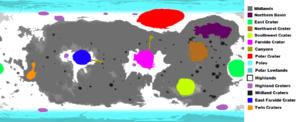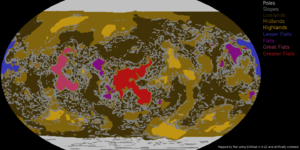Difference between revisions of "Biome"
(*moved all sections one level up; -random case; *rewritten section about that biomes don't need to be connected; +statement that experiments may only work once; -parenthesis;) |
m (*rewritten sentence about Laythe's and Eve's biomes;) |
||
| Line 1: | Line 1: | ||
| − | In KSP terminology, a '''biome''' is geographically contiguous area on the surface of a [[celestial body]]. They yield different experimental data (and flavor text). Currently{{Check version||0.23}}, only the Kerbin System, consisting of [[Kerbin]] and its moons [[Mün]] and [[Minmus]], have biomes. | + | In KSP terminology, a '''biome''' is geographically contiguous area on the surface of a [[celestial body]]. They yield different experimental data (and flavor text). Currently{{Check version||0.23}}, only the Kerbin System, consisting of [[Kerbin]] and its moons [[Mün]] and [[Minmus]], have biomes. There is another result when an experiment is done while swimming in a fluid. Because of this [[Laythe]] and [[Eve]] appear to have a second biome, although it is simply the first but gathered in the water. Depending on the experiment it might not work in water. |
Taking data at different altitudes (including 'on the ground', i.e. surface samples) over different biomes reveals different [[Science|scientific results]]. Scientific results always count for the complete biome, even if the biome are not connected other parts of the biome. For example the pole biome ''Ice Caps'' on Kerbin counts as one on both poles, as long as they are named the same, and results between both won't differ. Depending on the scientific experiment, it will either differ between all biome or between none and result always same. | Taking data at different altitudes (including 'on the ground', i.e. surface samples) over different biomes reveals different [[Science|scientific results]]. Scientific results always count for the complete biome, even if the biome are not connected other parts of the biome. For example the pole biome ''Ice Caps'' on Kerbin counts as one on both poles, as long as they are named the same, and results between both won't differ. Depending on the scientific experiment, it will either differ between all biome or between none and result always same. | ||
Revision as of 17:14, 10 March 2014
In KSP terminology, a biome is geographically contiguous area on the surface of a celestial body. They yield different experimental data (and flavor text). Currently[outdated], only the Kerbin System, consisting of Kerbin and its moons Mün and Minmus, have biomes. There is another result when an experiment is done while swimming in a fluid. Because of this Laythe and Eve appear to have a second biome, although it is simply the first but gathered in the water. Depending on the experiment it might not work in water.
Taking data at different altitudes (including 'on the ground', i.e. surface samples) over different biomes reveals different scientific results. Scientific results always count for the complete biome, even if the biome are not connected other parts of the biome. For example the pole biome Ice Caps on Kerbin counts as one on both poles, as long as they are named the same, and results between both won't differ. Depending on the scientific experiment, it will either differ between all biome or between none and result always same.
In real life, biomes are contiguous areas with similar climatic conditions and organism communities. Without organisms, there are no biomes.
Contents
Kerbin
The planet Kerbin has 9 true biomes which extend into airborne and orbital altitudes. It also has three surface-only biome special locations, all of which are at KSC, which KSC counts as Shores biome while in flight.
There is also a distinction between being on land in a biome or in water. Most rivers and smaller bodies of water are the same biome as the ground around them. Only large lakes and Kerbin's oceans are counted as Water biome areas. Shores make up medium-sized lakes and coastal areas, covering both beach areas and on out into the water. Interestingly, small islands in Kerbin's oceanic areas, such as at the Insular Airfield, sometimes are counted as surface landings, not splashdowns, within the Water biome.
Science can be done in landed and splashed situations within biomes where bodies of water can be found. Science can also be done in biomes at various altitudes.
Kerbin biome list
- LaunchPad
- Runway
- KSC
- Grasslands
- Highlands
- Mountains
- Deserts
- Badlands
- Tundra
- IceCaps
- Water
- Shores
Mun
The Mun has in total 15 biomes, 7 of which are large-scale major craters with specific names. Most of the surface area belongs to the Midlands biome followed by the Highlands. Canyon biomes extend off a few major craters.
There is no atmosphere on the Mun but some experiments can be done at various flight altitudes.
Mun biome list
- Northern Basin
- Highland Craters
- Highlands
- Midland Craters
- Midlands
- Canyons
- East Crater
- East Farside Crater
- Farside Crater
- Northwest Crater
- Southwest Crater
- Twin Craters
- Polar Crater
- Polar Lowlands
- Poles
Minmus
Minmus has in total 9 biomes. Unlike the Mun, none denote specific craters or other localized landmarks. The most distinctive quality of Minmus's biomes is the variety of Flats.
There is no atmosphere on Minmus but some experiments can be done at various flight altitudes.
Minmus biome list
- Highland
- Midlands
- Lowlands
- Slopes
- Lesser Flats
- Flats
- Great Flats
- Greater Flats
- Poles
Eve
- Ocean
- Land
Laythe
- Water
- Land
Other
All other celestial bodies have only one biome for the complete body. This will most likely change in the future.


